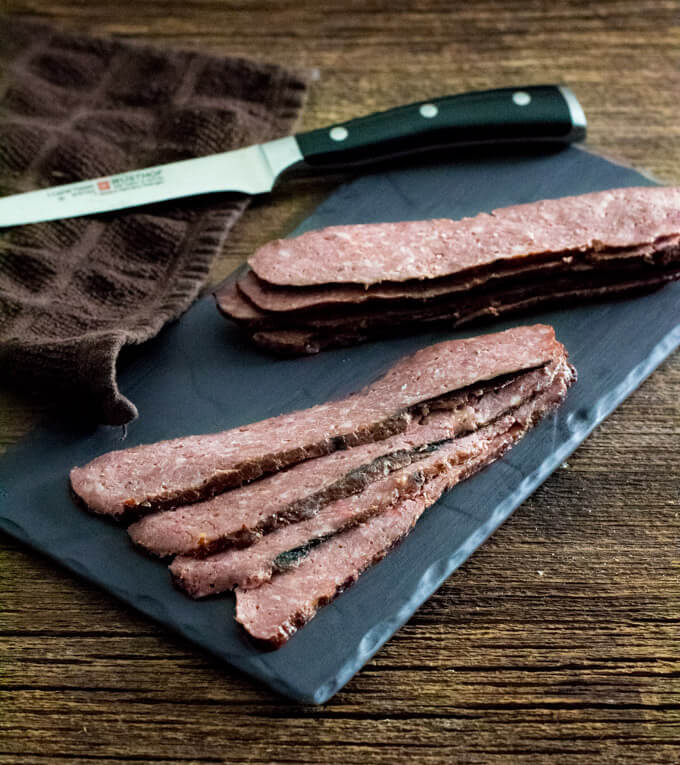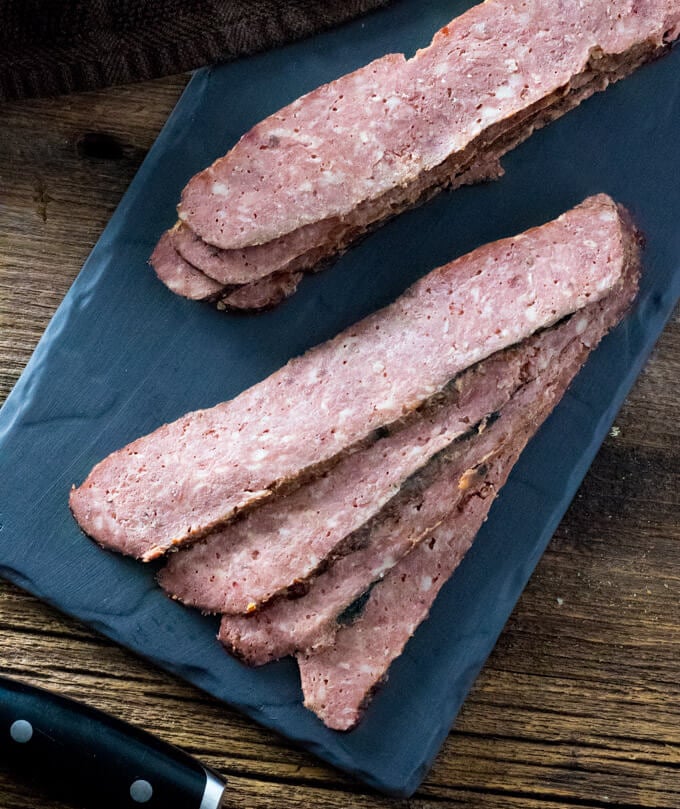If you season, cure, and smoke ground venison and pork fat, you can make venison bacon, which is sweet and smoky sheet bacon.
This recipe has been on my to-do list for a long time. People who like to hunt really like venison bacon, but I could never find a recipe for how to make it. I could only find ready-made cure mixes that I had to buy. For people like me who are proud to kill their own animals and make everything from scratch, that wasn’t okay. So I set out to create this recipe.
Venison bacon is made from ground meat instead of a whole cut of meat like pork belly in regular bacon. It is also sometimes called “formed ground bacon.” It is prepared and cooked like venison sausage, but loaded with bacon seasonings and thinly sliced.
Venison bacon is a delicious treat for hunters and wild game enthusiasts. Made from a blend of ground venison and pork fat it has the same smoky salty, sweet flavor of traditional bacon. The main difference is venison bacon is formed into logs versus being cured and smoked in slabs.
Determining the proper smoking time is key to getting perfect slices of venison bacon Follow this guide to learn everything about smoking times and temperatures
Why Make Venison Bacon?
There are several benefits to turning your venison harvest into bacon
-
Adds flavor and fat to the extremely lean venison. Pure venison would be dry and bland.
-
Allows you to use venison trimmings instead of prime cuts.
-
Results in a delicious smoked and cured meat that stores well.
-
Provides a tasty way to use a lot of venison at once.
Venison Bacon Ingredients
The basic venison bacon recipe calls for:
- Ground venison (80%)
- Ground pork fat (20%)
- Cure #1 or equivalent meat curing agent
- Seasonings – sugar, smoked paprika, salt, pepper, etc.
The pork fat is essential to add moisture and fat since venison is very lean. 20% fat is recommended but you can go up to 30% if desired. The seasonings and cure give it the classic bacon flavor profile.
Preparing Venison Bacon Logs
Proper mixing and binding of the ground meats is important for achieving good texture. Follow these steps:
- Grind venison and fat separately through a 3/8” plate.
- Grind together through a 3/16” plate to thoroughly incorporate.
- Mix in cure and seasonings until evenly distributed and sticky.
- Pack firmly into loaf pans, eliminating air pockets. Refrigerate overnight before smoking.
Determining Smoking Time
The smoking time for venison bacon can vary quite a bit based on the size and shape of your logs. Follow these tips:
- Form thinner logs around 2” thick. Thicker logs take longer to reach temperature.
- Use a meat probe thermometer to monitor internal temp.
- Smoke at lower temperatures between 130-180°F.
- Venison bacon is fully cooked at 160°F internal temperature.
- Expect smoking time to be 6-8 hours for 2” thick logs.
Step-by-Step Smoking Directions
Follow these steps for perfectly smoked venison bacon:
- Prepare seasoned meat logs and refrigerate overnight.
- Set up smoker or grill for smoking at 130-180°F. Use mild wood like apple or maple.
- Place logs directly on grill grates and insert thermometer probes into thickest sections.
- Maintain smoker temp between 130-180°F. Increase heat gradually over several hours.
- Smoke until venison bacon logs reach 160°F internal temperature.
- Remove logs and allow to rest before chilling thoroughly.
- Once completely chilled, slice into strips and cook as needed.
Smoking Tips
- Use a true smoking wood like hickory, apple, pecan, or maple for best flavor.
- Add a smoke tube if your smoker isn’t producing enough smoke.
- Monitor temperature closely and pull at 160°F. Do not oversmoke.
- Let logs rest before chilling to allow juices to redistribute.
- Chill thoroughly before slicing for clean cuts.
What if I Don’t Have a Smoker?
You can make venison bacon without a true smoker. Here are some options:
-
Use a charcoal grill – Add soaked wood chips to the charcoal for smoke flavor. Maintain temperature as low as possible, under 225°F.
-
Oven smoke – Place a smoker box of wood chips in the oven with the venison bacon logs. Keep temperature under 225°F.
-
Slow cook in the oven – Cook venison bacon at 200-225°F in the oven until internal temp reaches 160°F. You’ll lose some smoke flavor.
Troubleshooting Venison Bacon
Here are some common venison bacon issues and fixes:
-
Bacon is dry – Be sure to use at least 20% pork fat in the grind. Do not oversmoke.
-
Bacon is tough – Allow bacon to rest after smoking before chilling. Slice logs very thinly across the grain.
-
Bacon falls apart when sliced – Meat paste may have been too loose. Bind well before packing logs. Refrigerate overnight before smoking.
-
Bacon has off-flavors – Avoid heavy smoke flavors like mesquite. Do not oversmoke.
-
Not smoky enough – Use more wood, add a smoke tube, or smoke for a longer period of time.
Frequently Asked Questions
How much pork fat should I use?
20% pork fat to 80% venison is a good starting point. You can go up to 30% fat for added moisture.
What is the cure I need?
Use a commercial cure containing sodium nitrite like Cure #1 or Prague Powder #1. Follow the recommended usage instructions.
Can I use different woods for smoking?
Yes, just avoid very strong smoke flavors like mesquite. Good options are apple, maple, hickory and pecan.
What is the shelf life of venison bacon?
Venison bacon will last 1 week refrigerated and 6 months frozen when properly handled.
Is venison bacon fully cooked after smoking?
Yes, venison bacon is safe to eat after reaching the target internal temperature of 160°F.
Conclusion
With the right techniques, you can enjoy incredible homemade venison bacon from your deer harvest. Take your time selecting cuts, mixing the ground meats, and forming compact logs. Follow the step-by-step smoking directions, monitoring temperature closely. In 6-8 hours, you’ll have delicious venison bacon ready to slice and enjoy!

Does Venison Bacon Taste Like Bacon?
Venison has a distinctly different flavor than pork which will be reflected in the bacon. However, venison bacon does have the same traits as traditional bacon – wonderfully sweet, smoky, and salty!.

Equipment Needed for Venison Bacon
There are affiliate links in the list of things you need to make venison bacon that let you quickly and easily buy the same things I use from Amazon.
- Stick smoker—You can use a regular oven to make deer bacon, but smoking it will make it taste better. It is best to use an electric smoker for making any kind of sausage because it lets you control the temperature more precisely as you raise it gradually during the cooking process.
- Deli Slicer: Once the bacon is done smoking, you can use your chef knife to cut it into thin slices, but a deli slicer is much faster and easier to use. You can also use it to cut my smoked rump roast recipe into thin slices.
- Meat Grinder: You will need to use a meat grinder to grind your deer brains into bacon that is already formed. Read my How to Butcher a Deer tutorial for tips on how to grind deer meat.
Most likely, you don’t keep a few of the things you need for venison bacon on hand if you don’t usually make bacon or sausage.
- Curing—The meat needs to be cured because it will be cooked at very low temperatures for a long time. The cure stops dangerous bacteria from growing in the meat while it cooks, making it safe to eat. You can buy a lot of different cures. Always read the label to make sure you use the right amount.
- Dairy-Free Dry Milk Powder: You can get this at any grocery store. It is added to sausage to keep it together, keep the moisture in, and stop it from shrinking while it’s cooking.
- Brown Sugar—Smoky and sweet is the classic bacon pair. The brown sugar gives the meat a great sweetness and makes a sticky glaze on the outside. Feel free to add/substitute maple syrup as well.
- Ground Venison—I use a mix of ground venison and pork fat to make venison bacon. Somewhat less than 80% lean meat and 20% fat is a good starting point, but you can go as high as 30% fat if you want to. Make sure you don’t lose more weight than you need to, or your bacon will taste dry and lack flavor. If you had a butcher process your deer meat, you can ask them what fat ratio they used.

